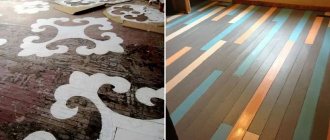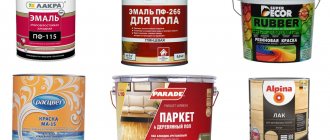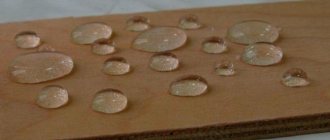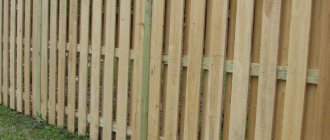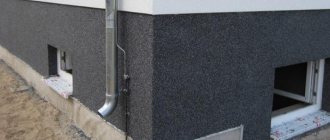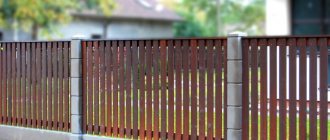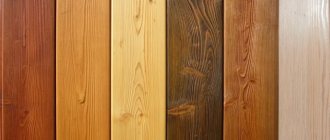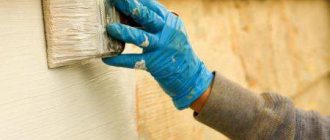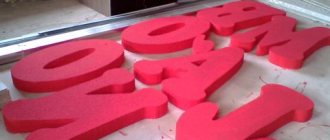The floor is one of the basic elements of the room, which means you need to choose and care for it as carefully as possible. Currently, wooden floors are especially popular, as building materials of natural origin have become fashionable. However, wooden coverings can deteriorate under aggressive environmental influences. You can preserve your floors using ordinary paint. But you need to choose it, taking into account the characteristics of the floor covering.
How to paint a wooden floor in a house?
Painting a wooden floor
Wood is a natural material that can quickly deteriorate without special protection. It follows from this that the main function of the floor covering is to protect it from rot, high humidity, mildew and mold. But this may not be enough. The decor of the house, including the flooring, should please the owners so that they enjoy spending time in it.
Important! If we are talking about a dacha, then today it is rare for anyone to store unnecessary rubbish there, which has no place in city apartments. Now, decorating a country house is a separate area of design, and therefore purchasing floor paint requires an individual approach.
There are many reasons to use paint:
- the paint does not allow the wood to absorb moisture or dry out;
- painted floors are not exposed to fungus or mold, and this increases their service life;
- painted floors do not require additional care - they are often simply enough to be washed;
- paint protects the material from temperature fluctuations;
- Thanks to paint and varnish products, you can easily create a beautiful and unique pattern.
Painting a wood floor is very important to protect it from moisture, mold and mildew.
White floor
White wooden floor
A white wooden floor looks very original. To get this result you need:
- carefully sand the new coating, which has not previously been covered with either varnish or paint;
- if defects (dents) are revealed, fill them with a special putty (in the store, when purchasing it, check whether it is tinted with colored oil and wax, or buy white putty straight away);
- cover the surface with white oil and hard wax (to do this, use a brush, after thoroughly mixing the composition in the jar);
Coating the board with white oil
- After 15-20 minutes, use a soft rag (cloth) to remove the composition that has not been absorbed into the wood;
- a day later, apply a second layer of white oil with hard wax in the same way.
Features of the use of floor coverings
When repairing a wooden floor, use one of two possible ways to update it. There is nothing complicated in the first method: first you need to choose a composition that is similar to the previous one, and then apply it to the coating. Using this method, you can avoid disturbing the layer of previous paint.
The second method is much more labor-intensive, as it requires impregnation and varnishing of the floor. But this option is much more effective, since it involves not only painting, but also restoration of the coating itself.
Important! To put the floor in order using the second method, you need to prepare the floor surface for restoration. To do this, it is smoothed and polished, and sometimes even completely changed.
You can apply paint to the old layer, or you can completely renew the surface of the wooden floor.
The preparation should be secured with several layers of clear varnish. This will give the surface strength and immunity to external adverse events.
If it is necessary to increase the service life of the floor, it is recommended to replace the old boards with fresh ones and cover them with paint and varnish products. True, with this option a lot of impregnation and varnish are consumed, because new boards absorb a lot of liquid.
Old floors
Old wooden floors
If you have old wood floors in your room, chances are they've already been painted several times. And therefore, it is worth focusing on the following points:
- Cover an old wood floor
with the existing floor color (painting over a dark shade with a lighter shade may require more than 2 coats of paint); - type of previously used paint (if you can’t remember what you painted the floor with the previous time, rummage through your “stocks” of materials on the balcony or storage room, because as practice shows, a paint jar is often not thrown away, and there is always some paint left in it );
- your financial capabilities and the availability of suitable paint in the store.
Alternatively, you can try to completely remove the old paint, scrape the floors and varnish them. However, if the floor boards have deteriorated during their “service” (they have become either “humpbacked” or, conversely, concave), no craftsman may take up the task of scraping the floor.
But parquet (almost all of it is made of oak), even old ones, is much easier to peel off. All that remains is to then coat the floors in two layers of varnish (with or without tint) over the primer.
Choosing paint for a wooden floor
Some people believe that wooden floors are an indispensable attribute of the old days. But this opinion is erroneous, since floors made from natural materials are often used even now to create a pleasant atmosphere and make the room more attractive.
Only with the help of proper floor painting can you achieve the best quality of the floor structure. This does not require special knowledge or skills. All stages of the procedure can be performed by yourself.
It is quite possible to paint the floor yourself - the main thing is to follow the technology
Before you start painting, you need to consider the following points:
- Is the flooring quality?
- what the final appearance of the floor should be after painting;
- what material is best to use in a given situation;
- How long does it take for paint to dry?
Ultimately, you need to have a complete vision of what should happen in the end, and based on this, make a choice in favor of one of the materials.
It would be useful to first familiarize yourself with the types of materials in order to have an idea of what to apply to the flooring so that it gives maximum benefit. Transparent products, such as various varnishes and impregnations, allow you to emphasize the natural texture of wood, but do not provide adequate protection from any loads.
You can use only varnish without applying paint - this will add beauty to the wood, but will not protect it adequately
You cannot move heavy objects or walk in heels on such a coating, as this will damage the protective layer, which will not be able to protect the tree from negative influences in the future.
When painting floors, you can forget about the natural beauty of wood, but in return you get a variety of colors that are obtained by choosing the right materials. In addition, the paint helps strengthen the coating.
Important! When choosing paint, it is important to consider the humidity in the room. By the way, in any case, you need to apply a protective layer only to a previously prepared floor.
The coating should be applied taking into account the selected materials in this way.
- Varnish. One layer of varnish is applied to the previously prepared coating. After it dries, the surface is leveled with fine sandpaper and cleaned. Then, using the same principle, a couple more layers are applied, but not less than three.
- Dye. Drying oil is first applied to the boards. After hardening (after 3 days), the floor is painted 2 times. Once the paint has dried, you can safely move around it.
Several layers of paint are required
When re-treating the floor, you need to take into account the degree of preservation of the coating. In a situation where the quality of the floor is called into question, it is worth re-laying the entire floor again. This will save you from problems.
Paints and compositions for floor treatment
How to paint a wooden floor in a dacha in unheated rooms in winter? Before immediately starting work on painting a wooden floor in a seasonally used country house, it is necessary to determine the most suitable mixtures for the operating conditions for preliminary and final finishing treatment.
On the construction market, such materials are presented in an assortment and include:
- Protective compounds. Designed to prevent rotting of boards, the emergence of microorganisms, and the creation of fire-fighting properties, including:
- fire retardant, give the wood the properties of self-extinguishing in the event of fire;
- antiseptic preparations, the basis of which can be alcohol or water, help prevent the appearance of microorganisms and bacteria that provoke wood rotting;
- water-repellent impregnations based on oil compositions, characterized by a deep degree of penetration into the structure of a wooden board and have moisture-repellent properties due to the use of resins and vegetable oils in the composition.
- Varnishes are transparent with a glossy or matte appearance after drying. This finishing coating allows you to emphasize the primary structure of the natural pattern on the wood. At the same time, it is demanding in terms of preliminary preparation of the surface of the floor boards. It is necessary to apply grinding and complete removal of surface defects. Strength is conditional. Exposure to external factors associated with temperature changes and mechanical stress during operation leads to the need for frequent updating.
- Oil-based or alkyd-based paints for wooden surfaces There is a wide choice of paint colors. After final drying, the material has properties that ensure long-term operation and is resistant to difficult conditions of use and temperature changes.
Important! When purchasing paint and varnish compositions for application to floor coverings made of wooden planks, you must carefully study their technical characteristics and features of use in the intended operating conditions. To clarify the nuances of using a particular composition, it is recommended to consult with specialists from the trading organization.
Floor paint
- Acrylic water dispersion compositions. Practically do not contain active solvents and harmful elements. Due to these properties, it is recommended to use it for painting dacha floors in bedrooms and other areas where people are predominantly occupied. Sufficiently protected from external climatic influences.
What to look for when purchasing?
Despite the fact that paint is one of the most popular materials for flooring, it must be chosen very carefully, because the floor should serve not only for protection, but also for decoration. Well-chosen paint can not only improve the quality of the coating, but also emphasize its appearance and structure. When purchasing, you need to consider the following points.
- Variety of varieties and types of wood. Because each type of wood reacts differently to paint, the amount of material required for painting varies.
- Conditions for using paint. Different paints are used to paint the floors inside and outside the building.
- Terms of use. Finishing materials can be used to cover both fresh boards and newly repaired ones.
When choosing paint for the floor, you need to pay attention to many nuances
- Quantity and composition of old finishing. Such information is required in order to select a product that can be combined with the previous one.
- Coverage quality. In some cases, pre-treatment of the wood may be required.
All these factors should help determine which paint to choose from the huge selection.
Choosing material for painting the floor at the dacha
Flooring made from planed boards is a durable, beautiful and reliable finishing material. But under one condition: the tree must be protected from dirt, dampness, direct contact with water and much more. We will tell you how to paint a wooden floor in a country house.
Brief classification of household paints and varnishes
There is a whole class of protective paints and varnishes for wooden floor materials:
Enamels
These are multicomponent film-forming protective and decorative compositions. The following are used as a basis:
Oil enamel MA-15.
- Mineral oils. Most often this is drying oil of various brands. The resulting oil paint is opaque, fits perfectly on metal products, and is suitable for concrete and wood. It is a universal mixture, meaning it can be used inside and outside buildings.
- Solvents. This category includes mixtures of cellulose ether resins in acetone and other similar compounds - nitrocellulose and others. Do not confuse with alkyd and urethane enamels: they contain white spirit or nefras, but they are not the basic components.
Important! It is not advisable to combine acetone-containing enamels with other types of paints, since the reaction of the substances can be unpredictable. For example, an acrylic composition applied over NC, instead of a glossy smooth surface, will give a matte one, or even worse, a spotty one, which will soon begin to crack or peel off.
- Synthetic resins (alkyd, acrylic, polyurethane). Includes enamels such as alkyd, urethane-alkyd, acrylic and others. This is the most common type of paint, giving a dense, opaque film of a certain shade.
All compositions are applied to a sanded surface free of dirt, grease-containing substances, and the finished coating is hard, durable, resistant to abrasion and climatic changes. Thickness and impact resistance depend not only on the number of layers, but also on the density of the mixture, the level of thixotropy, and even on the application technique. For example, if all the rules are followed, the thickest layer is obtained when working with a roller, and the thinnest when using sprayers.
These are complex solutions consisting of:
- special components with high film-forming ability - natural or polymer resins, bitumen, etc.;
- organic or synthetic solvents;
- various additives that help improve the quality of the film - plasticizing, hardening, promoter (strengthening adhesion to the surface), pigmenting, etc.
They form a transparent or translucent film with a tinting effect on the surface, emphasizing the texture of the wood, especially highlighting its beauty and aesthetics. Like enamels, this type of product is classified depending on the base:
- Oily - a series of compositions obtained by mixing organic solvents, vegetable oils and natural or polymer resins. The most striking example is oil-rosin varnish, which, like all others, is used for processing furniture and other wood products. The film turns out yellowish, but transparent, and highlights the wood texture well. This is a product for interior work.
Solvent varnish.
Oils and waxes
- Oils and waxes are mixtures of natural and synthetic fat-containing substances intended for rubbing into the surface of wood. They do not create a film on the floor, but are absorbed into the pores, sealing them and creating a barrier against moisture and dirt. What many buyers like about these compositions is that a film does not form on the treated surface, but the appearance of a clean, warm material is maintained. The disadvantage of oil-wax compositions is that they wear off quickly, so the coating must be constantly renewed.
Let us remind you once again: the most common household compounds that you can use to treat a wooden floor with your own hands are discussed above. Of course, this classifier is incomplete; there are many other tools. However, it is recommended to use these paints and varnishes for the home as they are the safest and most practical.
Paint selection
If you choose the right paint, you can not only decorate your wooden floor beautifully, but also preserve it for a long time. It is very important to pay attention to the following details before purchasing.
- What paint was used previously? For example, a coating that can withstand sub-zero temperatures is suitable for a balcony. For rooms with high humidity it is better to use moisture-resistant coatings.
- Interior decoration. The paint color should match the overall design. Currently, the choice of colors is so diverse that there should not be any problems with this. If there are any doubts, you can opt for white, which is considered universal.
It is important that the color of the floor paint matches the overall design of the room
- Wood species and texture. The surface of the pine flooring is quite soft and flexible, so it needs additional protection and strength. For it you need to choose a paint with these properties. Beech flooring has a glossy sheen and a non-standard texture, which means it is worth using coatings that can highlight this. You can also apply oil impregnation to the beech surface before painting - this will preserve the properties of the wood.
- Type and characteristics. Transparent products, such as impregnation or varnish, do not allow oxygen to pass through well, and their layer becomes thinner over time. However, they enhance the shine of surfaces and protect them from solar radiation. But they need to be applied to an already painted surface.
When choosing paint, you need to consider what kind of coating it will be applied to - for example, different materials are suitable for pine and beech floors
When the choice is made and the paint is purchased, you can begin preparatory activities.
Choosing a material for painting the floor
To protect the wood from moisture and to give it a finished appearance, owners should find out what is the best way to paint a wooden floor in their dacha.
After all, the correct choice of paint and varnish is of considerable importance for painting. First of all, you should pay attention to the type of wood, consider all possible methods of preliminary surface preparation, conditions and service life, as well as compatibility with the previously used coating.
So, how to paint a wooden floor in a country house?
In appearance, all paint and varnish materials are divided into 2 types:
- Transparent (varnishes and various impregnations).
- Opaque. This type includes solvent-based paints (polyurethane, perchlorovinyl, alkyd, acrylic, oil-based) and water-dispersion. The most popular of them include alkyd, polyurethane and acrylic paints, as they provide high-quality coverage and are quite easy to use.
Preparing for painting
The preparatory stage includes several stages:
- preparation of a wooden surface, primer;
- painting.
To prepare the work surface, you need to do the following.
- Clear the room of furniture and equipment and wash the floor. To do this, it is better to use soapy water, especially if there is severe contamination.
- The surface must be cleared of debris and remnants of old paint. If there are cracks and roughness, they can be removed using grinding equipment.
- Gaps and cracks must be filled with putty or other suitable solution. Usually it is necessary to put several such layers. In this case, each subsequent layer must be applied only after the previous one has dried.
- Re-sanding. When the solution dries, its surface needs to be smoothed.
- Next, they are treated with a primer, the properties of which correspond to the selected paint.
It is necessary to prepare the floor for painting - free it from debris, old coating, seal cracks and cracks
At this point, the preliminary preparations are considered complete, and then you can begin painting.
wood putty
Protective impregnations
Before painting a new wooden floor in a country house, it must be pre-treated with special compounds that are sold in all hardware stores.
They are applied to increase fire safety, significantly increasing the ignition temperature of the wood material, and to give it the ability to self-extinguish. Such impregnations are often used in public and industrial buildings.
- Alcohol- or water-based biocides and antiseptics.
These products protect wood from the growth and development of microorganisms and various putrefactive bacteria, and the effects of insects, thereby increasing the service life of the floors. Such impregnations can be deep and superficial. At home, as a rule, only superficial products are used. Application is carried out with a brush or spray on cleaned wood. Surface impregnation is used in places where it is necessary to preserve the natural structure of wood and its aesthetic appearance. The wood is coated with a special composition that has fire and bioprotective qualities and protects against infection by mold and fungi, prevents rotting, and increases the service life of floors compared to simply painted ordinary varnishes and paints.
Deep impregnation is carried out in industrial conditions, using special baths and an autoclave, where a solution of biocides and fire retardants is “driven” under pressure into the wood, filling the entire possible volume.
They are most often made from wood and linseed oil with modifying additives based on artificial or natural resins. The products are used to tint, protect and strengthen wooden floors. The oil can be absorbed into the wood much deeper than the varnish, the surface becomes stronger, becomes moisture resistant and shiny. It is better to choose oils without solvents, natural, and not drying very quickly. If you have not yet decided how to paint the wooden floor in your dacha, then we advise you to opt for an oil coating. This is the most optimal solution for unheated rooms and places with high traffic. Before impregnation, the surface should be cleaned and dried thoroughly.
Coloring
To start painting, you need to wait until the floor is completely dry after priming. After this, the painting area should be marked with paper or masking tape.
Different paints have their own painting technology. To paint the floor with a roller, the paint is first mixed and poured into a special tray. After this, the roller is dipped into the tray and the surface is painted. It is better to start from the far corners of the room. Before working with a roller, all hard-to-reach places, as well as baseboards, must be painted with brushes of different widths.
Important! To properly paint wood, paint is often applied with a spray.
The technique of painting with rubber paint requires special attention, as it must be performed in accordance with the rules:
- First, the paint must be mixed, and if necessary, add water;
- for application you can use either a roller, a brush or even a spray;
- during painting, the temperature in the room should not be lower than +5 degrees;
- During the painting process, the paint must be stirred so that it does not have time to harden;
- You only need to paint a dry and clean surface;
- Regardless of what kind of paint is used, after complete drying the painted surface should be washed with warm water.
If painting is done in several layers, you need to wait until the previous one dries before applying the next one.
Painting is a labor-intensive task, so the whole process needs to be thought out in advance and careful preparation carried out.
Preparing the floor surface for painting
Before directly painting the floor made of wooden planks in any room, especially one used seasonally, there must be preparatory measures that include the following:
- purchasing the necessary paint and varnish coatings and consumables (sanding accessories, brushes or paint rollers, etc.);
- removal of furniture or hanging elements from the premises;
- if it is not possible to remove interior items, provide them with shelter from dust;
- cleaning the floor surface from various types of contaminants (oil, household origin);
- removing a layer of old paint coating using chemical compounds or mechanically;
Removing old paint
- elimination of defects using putty material and further processing after the composition has completely dried;
- sanding the surface manually or automatically;
- removing dust from the room and wet cleaning.
Preparing the surface for painting
Important! The condition for painting the floor surface of wooden planks in unheated rooms is the establishment of weather conditions that provide positive temperatures and moderate air humidity.
Recommendations
To paint your floors perfectly, you need to take into account the following points:
- For painting you need to prepare spare working tools or materials. Rollers and brushes should be of different lengths, widths and shapes;
- You should only purchase paints from well-known brands after familiarizing yourself with the composition and accompanying documentation;
- the type of paint should be selected taking into account the texture, species and texture of the wood;
- When painting residential premises, you need to choose paint that is odorless and has no toxic inclusions.
Important! Paint and varnish products intended for wood processing can provide the necessary care and protection, and they are varied in appearance and color.
Before you start painting the floor, it is better to prepare several rollers and brushes of different lengths, widths and shapes
Types of wood coatings
Paint for wooden floors in the country house is divided into transparent and opaque compositions.
Transparent are varnishes and primers of various modifications with or without a coloring pigment. If there is no antiseptic in the structure of their mixture, then it is recommended to treat the surface with anti-rot agents before painting. Putty and primer also help extend the life of wood.
- Protective impregnation. Application of pest and fungus repellent: antiseptic, fire retardant. It is used to preserve the wood structure from negative environmental factors: temperature changes, exposure to ultraviolet radiation, high humidity, insects.
- Primer. This treatment extends the life of the floors of a country house and protects the wood from fungus, mold, and rot. In addition, applying a primer is necessary for complete adhesion to the paint composition.
- Puttying.
- Painting.
Characteristics of transparent paints and varnishes
Before painting a wooden floor in an unheated country house, first pay attention to the characteristics of paints and varnishes.
Types of materials for priming and wood processing
- Acrylic is a universal composition for all types of building materials.
- Shellac is a primer designed for treating new wood surfaces.
- Aluminum - all types of wood are treated with this composition.
- Polyvinyl acetate - it is applied to previously puttied wood.
Wood processing can be done using organic substances.
Oil and wax are a mixture of fat-containing elements that do not create a film. It is recommended to paint the floor with oil in two or three layers. It is advisable to remember that these products are short-lived and require regular updating.
Types of paints and varnishes for wood surfaces
Varnish is a material composed of polymer and natural resins. It forms a dense transparent or translucent film and emphasizes the natural grain of the wood. It is often applied over paint.
- Polyurethane – its qualities: high wear resistance, water resistance.
- Epoxy is a mixture of epoxy resin and solvent, which is not used without a hardener.
- Acrylic is a universal water-based paint coating, one of the components of which is an antiseptic.
- Yacht (deck) – the composition is intended for finishing sea and river vessels. It is not recommended for use for interior work due to the presence of dangerous toxic substances in its composition.
- Alkyd varnishes are a mixture of alkyd resin with an organic solvent. It creates a dense transparent film that is resistant to mechanical stress.
Popular brands
Since paints are one of the most popular products on the construction market, many companies are involved in the production of this product. Of all this variety, the following popular brands are worth noting.
| Firm | Description |
"Tikkurila" | This brand is an indicator of high quality. It is produced by a Finnish company whose products are in great demand in this market. For flooring, paints from the Betolux series are best suited. |
"Dulux" | Despite the fact that the paints of this company are of high quality, it is still inferior to the manufacturer described above. |
"Polisan" | Products of Turkish origin belong to the middle price segment and are suitable for solving ordinary problems. |
There are, of course, a lot of other paint manufacturers: “Knauf”, “Soudal”, “Ceresit” and so on. All products from these companies are quite popular, differing only in quality, composition, and method of application.
Features of the floor on the verandas
Many owners of private cottages and summer cottages are forced to repair the flooring on the veranda every year. This is due to the influence of various factors during operation. In addition, weather conditions are important factors. Open verandas cannot be protected from the elements. In such conditions, even reliable and durable materials can be destroyed.
When choosing the right technology for laying wooden floors on the veranda, they last much longer. The tree will not collapse within several years, as is the case with improper processing. For example, if the boards are laid with a gap of 5 mm, the structure will be less susceptible to moisture. The veranda flooring will be well ventilated. The boards will not absorb moisture, which will reduce the chances of rot.
It must be taken into account that even with ideal installation of the boards, the unprepared wood of the veranda flooring will not be protected from destruction. Various paints and varnishes are selected depending on the type of coating to be laid. I usually make floors on verandas from pine. It should have a natural level of humidity. If your budget allows, you can pay attention to decking boards for the veranda. It is made from wood shavings and polymer compounds. To understand how to paint a wooden floor on a veranda, you should understand the features of different compositions.
Similar products for covering wooden floors
To preserve the natural pattern of a wooden floor covering, you need to select transparent products:
- oils;
- impregnation;
- varnishes.
Using varnish you can provide reliable coverage for a long time. It forms a hard protective shell that preserves both the color and texture of the wood. Mastic was always used for varnishing and polishing oak parquet. This product is great for hard wood. But for soft varieties, such as pine, it is better to use a plastic transparent composition. Otherwise, after some time you may find cracks or dents on the floor.
To preserve the natural color of wood, you can use varnishes
Wooden flooring, assembled from inexpensive softwood, is treated with special products that contain pigments that enhance the natural texture and color of the wood. Biological compounds do not pose a danger to people, and they also have fire retardant properties. Surfaces treated with this composition do not rot for a long time and do not suffer from pests and fires.
Oil impregnations are compounds made on the basis of natural ingredients: natural resin, wood or linseed oil. With their help, you can protect and tint the coating, increase its wear resistance. Oil is much more plastic than varnish - this allows the product to be absorbed into the deeper layers and make them stronger.
Important! Impregnations should be used to treat high traffic areas.
Oil impregnations are best suited for unheated rooms. Therefore, they can be used to paint floors on the veranda or terrace. The same composition is good for use in rooms with high humidity. This will make the wood water-repellent and protect it from mold.
Oil impregnations can be used
To protect wood from fungus, mold and insects, it is treated with antiseptics. They can also be used at home by surface spraying. For deep impregnation, production conditions are required. In specialized markets you can purchase treated wood for flooring.
How to paint the floor
A fur roller is best suited for painting the floor.
Since painting the floor is not an entirely simple job, you should be very careful in preparing the tools with which the work will be done.
The standard set includes rollers, brushes, paint tray, masking tape:
- When choosing a roller, you should pay attention to whether its characteristics comply with GOST No. 10831-87. So, according to the requirements, it must be made of fur and be marked VMP (fur roller for the floor). The fur should not have a seam, as it will leave an uncolored or lightly colored stripe. In addition, the roller must have a handle of the required length or have a hole on the handle for attaching an additional handle extension.
- To ensure that the paint is evenly absorbed into the fur surface of the roller, you should use a paint tray that has a horizontal line along which the roller is rolled before using it on the flooring.
- To apply paint in places where it is difficult or impossible to work with a roller, brushes of various widths are used. They can also be used to paint baseboards, corners and edges of the floor. Some specialists use brushes to paint the floor.
- Those places that cannot be painted are covered with masking tape, which is removed after the paint has dried. To learn how to choose the right brushes and roller, watch this video:
Recently, when deciding how to paint the floor in a wooden house in the country, they give preference to paint sprayers such as PaintZoom, which allow you to save not only 60% of paint consumption, but also reduce the time to complete the work by 3-4 times.
Preparing for painting
Paint is suitable for covering inexpensive wood; it is better to varnish oak surfaces.
You should start painting the floor after purchasing the appropriate paint, which is chosen based on the following requirements:
- The humidity level of the room is taken into account. And since we are talking about the wooden floor of a country house, in which people live only in the summer, the rest of the time the floors will be in the cold and, accordingly, with high humidity.
- What kind of wood is the floor made of and what is the condition of the coating at the time of painting.
- What load will fall on the floor in a particular room of the dacha. So in the kitchen and hallway the load intensity will be much greater than for other rooms.
- How long does it take for paint to dry? Thus, the oil paint that is familiar to everyone, which is characterized by good wear resistance and also costs less than other types of paint, takes a long time to dry. And enamel paints, which are much more expensive than oil paints, dry quickly. However, oil paints have a wide range of heat resistance from low to high temperatures.
- If the floors in the country house are made of oak boards, you should choose not paint, but varnish, which, after application, gives the coating the beauty of the textured oak pattern.
The table provides information that allows you to decipher the data indicated on the paint cans:
| The letters indicate the type of film-forming agent | The first digit indicates the area of application | ||
| PF | pentaphthalic | 1 | Weatherproof, for outdoor use |
| AK | acrylic | 2 | Limited weather resistance, for interior use |
| PU | polyurethane | 4 | waterproof |
| NC | nitrocellulose | ||
| MA | oil | 8 | heat resistant |
Having decided on a specific paint or varnish, you should calculate its need.
Usually, on each can of paint there are instructions for use and the consumption is indicated per 1 sq.m. when covering in one layer.
Practice shows that on average, from 200 to 250 grams are consumed. For more information on how to paint floors, watch this video:
Experts recommend applying paint in several layers, so you need to purchase almost twice as much.
Painting a wooden floor
Start painting from the corners
When starting to paint, pour the required amount of paint into one container and mix thoroughly to make it uniform. Before you paint the floors in your dacha, you should understand the procedure for performing the work, which is as follows:
- Painting should begin from the corners of the room and along the walls. It should be borne in mind that the floor should be without skirting boards. The paint is applied with a brush.
- After painting the perimeter, you can begin to paint the rest of the floor area. The work is already being done with a roller.
- After letting the paint dry, install the baseboards in their place and paint them with a brush. It should be kept in mind that skirting boards are painted several times.
- After the baseboards, the paint is applied in a second layer to the entire surface of the floor.
After the floor surface is completely dry, it should be washed. Many online construction resources contain recommendations that such work should be carried out using a weak soap solution, since it effectively removes the stickiness of the painted surface. To learn how to varnish a wooden floor, watch this video:
However, experienced specialists prefer clean water, to which a small amount of acetic acid is added. This solution will not only eliminate stickiness, but also give the painted surface a glossy appearance and shine.
TOP popular floor paints
Polyurethane
TIKKURILA BETOLUX AQUA
Polyurethane-acrylate enamel, high quality and durable. Easy to apply to the surface. In stores you can find it in packages ranging from 0.9 to 18 liters. Price: 0.9 l is 965 rubles. But 2.7 liters will cost 3,500 rubles.
TIKKURILA BETOLUX AQU
Advantages:
- Economical;
- Diluted with water;
- There is no need to prepare the surface to apply enamel;
- Applies to old paints and varnishes without destroying their structure;
- It not only covers dark spots, but also evenly levels the wooden surface.
Flaws:
- In case of freezing, it loses all its properties;
- It is necessary to tint all the paint, because then it will become impossible to choose a shade;
- Expensive.
Acrylic
ArmorSeal Sherwin Williams
Expensive enamel, but at the same time it is an environmentally friendly product. The composition includes only one component. The price of a jar will cost from 7 thousand rubles and more.
ArmorSeal Sherwin Williams
Advantages:
- Dries within 4 hours;
- Durable, can be used in industrial warehouses with high mechanical friction;
- Wear-resistant, can last for decades if properly cared for;
- Does not require reapplication;
- Suitable for painting any surfaces;
- Completely safe enamel. Does not emit a pungent odor during application or during operation;
Flaws:
- Price. A 3.8 liter can costs from 7 thousand rubles.
ACRYLIC ENAMEL “PROFI” VD-AK-1179
Price for 2.5 kg – 750 rubles.
When dry, it does not evaporate, thereby not releasing toxic gases when applied. Dries completely in 24 hours, with the 2nd layer applied after 3 hours. Combines practicality and reliability.
ACRYLIC ENAMEL “PROFI” VD-AK-1179
Pros of coverage:
- Easy to apply and lasts a long time on chipboard floors;
- Washable with light chemical solutions;
- Withstands mechanical friction and does not fade in the sun;
Flaws:
- No.
AQUASTRONG BYTKHIM
Paintwork materials are sold in almost all construction stores. Its advantage is that it is suitable for painting walls and surfaces in rooms with heavy mechanical load. For example: garages, warehouses, industrial workshops.
AQUASTRONG BYTKHIM
Advantages:
- Does not lose its properties when exposed to acid, machine oils, alkali and prolonged friction.
- Apply with little effort using a roller.
Flaws:
- The only negative is that the surface is prepared and primed before painting.
The price varies from 1200 to 7 thousand rubles per jar.
Oily
Sniezka Podloga
Polish-made enamel, used for painting floors. Suitable for application in damp rooms, but the temperature is not lower than 10 degrees. Price 2.7 liters - 1100 rubles.
Sniezka Podloga
Pros of enamel:
- Abrasion resistant.
- It has high hardness, which allows you to create an ideal smooth surface.
- Economical. One can can paint a floor of 12 square meters.
Minuses:
- Price;
- Dries in 48 hours.
Drevopol Krasko
It was specially developed for painting wooden floors. Can be used for interior and exterior work. Price for 20 kg – 3 thousand rubles.
Drevopol Krasko
Advantages:
- The composition includes enamel, antiseptic, primer. This allows you to create not only a decorative coating, but also protect the wood from mold and dampness.
- Sold in three colors: light green, blue and white. The manufacturer expands the color range when ordering over 100 kilograms.
Flaws:
It has some advantages and no disadvantages.
Latex
DRYLOK LATEX CONCRETE FLOOR PAINT
This coating works great on concrete floors. In this case, the surface is not prepared, the paint goes on smoothly and neatly. It is used for painting walls and floors in any climatic conditions. It is quick-drying, completely dry after 5 hours. It has no disadvantages, only the price. You will have to pay 5 thousand rubles for it.
DRYLOK LATEX CONCRETE FLOOR PAINT
Benefits of coverage:
- Easy to apply and non-slip;
- Suitable for coating concrete, brick, cement masonry;
- Gives a pleasant matte finish to any surface.
ROYAL PORCH&FLOOR ACE PAINT
This is an environmentally friendly material. It contains latex, which not only does not emit odor, but also gives the material environmental properties. They can paint any surface, even metal, not to mention glass, plastic, and concrete. And they apply amazingly on wood. Drying time is only 48 hours, and it is recommended to use the room after 6 days. This paint and varnish material has a green building certificate. 3.8 liters costs 7,200 rubles.
ROYAL PORCH&FLOOR ACE PAINT
Advantages:
- Non-toxic;
- Paints any surface;
- Resistant to temperature changes;
- Wear-resistant enamel;
Flaws:
- Price;
- Dries within 36 hours;
- The premises can only be used after 7 days.
Dufa Retail Eurolatex 3
High quality German enamel. Probably the best among latex paints and varnishes.
Dufa Retail Eurolatex 3
Advantages:
- Applies in an even, uniform layer in rooms with moderate humidity;
- Creates a smooth matte finish that can withstand frequent wet cleaning and partial mechanical stress;
- It is odorless, so it is used in residential areas and children's rooms;
- Price: from 400 to 1 thousand rubles per 2.5 liter jar.
- Can be washed with chemical solutions with alkali;
There is only one drawback:
- Colored enamel darkens over time
.
Sniezka Perfect
Expensive, but at the same time economical paint. For 9 kg you will have to pay 2 thousand rubles.
Sniezka Perfect
Pros:
- Economical, one liter is enough to paint 14 square meters;
- At the same time, it does not smell, dries quickly and retains its original shade for a long time;
- Suitable for painting concrete, wood and wallpaper;
- Does not wipe off when using chemical solutions during cleaning.
Flaws:
- No.
Alkyd
Floor enamel PF-266 Yaroslavl Paints
A cheap option that has a persistent unpleasant odor. It is recommended to paint floors made of wood, plasterboard, and fiberboard.
Floor enamel PF-266 Yaroslavl Paints
Advantages:
- Applies carefully and does not smear.
Minuses:
- Dries in about 72 hours, the smell completely disappears after a month;
- Toxic. When using it, you must wear a respirator.
In the online store you can buy a jar of enamel for 200 rubles.
Rassvet enamel for floors, quick-drying
Used for painting wood floors. You can buy it for 250 rubles in a 900 gram jar.
Rassvet enamel for floors, quick-drying
Advantages:
- Dries quickly, dries completely within 24 hours, has virtually no odor;
- It gives the floor an unusual gloss that does not lose its properties over time;
- The enamel can withstand wet cleaning;
Minuses:
- Material consumption;
- When using a special roller tray, it thickens quickly, so it often needs to be diluted with a solvent.
Enamel PF-266 for the floor “Prestige Premium”
The weight of the can is 2.8 kg, you will have to pay about 600 rubles for them. But, in this case, the client will receive a not very high-quality product.
Enamel PF-266 for the floor “Prestige Premium”
Pros:
- Affordable price.
Disadvantages of LMB:
- The enamel takes a long time to dry and has a chemical smell. It cannot be used without a respirator. Moreover, it will be possible to enter the premises only in a week.
- After painting, the floors do not have a gloss, are poorly painted, and are not washed, creating the effect of dusty floors. It is unpleasant to walk on them barefoot.
But if you need to update your closet or garage, then this enamel will work well.
PF-266 Tex "Universal"
Quite good quality paintwork with one drawback. It takes a very long time to dry.
PF-266 Tex "Universal"
Advantages of paintwork materials:
- It goes on smoothly and covers all the unevenness. It has 100% coverage.
- During use it does not lose its original color. It has an unpleasant odor that disappears only after a day.
Flaws:
- The manufacturer claims that it dries in 20 hours, but in reality it dries in just three days. And if you paint it in two layers, the drying time is about 7 days.
FARBITEX
Designed for painting wood. Gives the surface a pleasant gloss. At the same time, it applies well, but after a while it loses all its properties.
FARBITEX
Pros:
- reasonable price, only 151 rubles per 0.8 g.
Minuses:
- Exposure to hot objects, vegetable and animal fats, machine oils;
- It is not recommended to use chemical solutions;
- Does not withstand mechanical friction;
- In addition, it also takes a very long time to dry, up to 5 days.
Choice of paint coating
Choice of coverage
The variety of paint and varnish coatings intended for treating wooden floors is simply amazing. In such a situation, it’s not surprising to get confused. When choosing a paint material, consider the following:
- Wood species.
- Operating conditions. This includes the humidity level, temperature conditions, and whether there is heating.
- Compatible with the previous coating (if we are talking about old floors).
All paint and varnish coatings intended for wood coatings are conventionally divided into transparent and opaque. If we talk about transparent compositions, they can be divided into 3 types:
- Lucky.
- Oils.
- Waxes.
Varnishing
Varnish is essentially dissolved natural solid resins; nowadays they are also synthetic polymers. Depending on the solvent included in the composition, varnishes are divided into several types:
- aquatic;
- turpentine;
- alcohol;
- oil;
- polyurethane;
- urethanized;
- polyurethane-acrylate.
There are cases when varnishing the floor is unacceptable:
- The old coating was previously treated with drying oil or other oil compounds.
- Outdoor areas - terraces, gazebos, verandas.
- In rooms with high humidity levels.
Painting
The floor is covered with opaque paint in order to protect the wood from mechanical stress and, if the quality of the wood is not presentable enough, to preserve its natural structure.
Worried about the health safety of paint? In this case, water-dispersion paint is suitable for you. Its advantages are long-term color retention and ease of application to a wooden surface.
The main advantage of painting the floor is that it can be repainted several times if necessary.
READ MORE: Cold and hot welding of linoleum: rules for carrying out work
Oil coating
The most ancient method of covering a wooden floor is treating it with oil. This is an environmentally friendly technique. For these purposes, sunflower, soybean, wood, and linseed oil are used. As well as natural modified resins and synthetic polymers.
An oil-soaked floor will not swell or dry out. You have the opportunity to choose an oil that will not affect the color of the wood. There are oils that change color from whitish to red-yellow, brown and black.
Wax coating
When making wax to cover wooden floors, linseed oil, beeswax and other additives are used. Wax-coated wood has a golden hue and shimmers with a silky light.
It is interesting that in the past, polishers were used in royal palaces, whose task was to rub the wax floor daily with a special tool.
Rules for applying enamel to floors
- We carefully study reviews about paintwork materials.
- We study the instructions on the tank with enamel and consult with the sales consultant.
- We prepare the surface as necessary. It all depends on the chosen floor paint.
- Degrease the surface and coat the wood with oil if necessary.
- We apply the enamel directly in several layers, from 3 to 5.
- Coat with varnish or oil to obtain gloss.
Dyeing process
Painting a wooden floor is not difficult. A person who knows how to use a paint roller or brush will be able to get the job done. But automated means will save time and sprayed paint: a spray gun with a compressor will be useful. Recommended preferences in choosing brushes: for painting - with long bristles, for varnishing - with short, hard bristles.
For rollers, the requirements are simpler - just find a tool that is dense and without falling out lint.
When the lion's share of the preparation has been completed (the choice has been made between paint and varnish, its color, preliminary work has been completed), it is time to paint hard-to-reach areas (corners, baseboards, areas around pipes). It is advisable to use variations in brush length and shape.
To paint the floor covering for a summer house, namely its central section, use a roller, starting to apply strokes on the side opposite to the door. Allowing air into the room (draft, but without the penetration of dust from outside) will help the mixture harden. Before painting the next layer, you should wait until the previous one has completely dried.
When choosing a painting method using a spray gun, it is advisable to use protective equipment: a mask or respirator, goggles to prevent paint from getting into your eyes, and gloves.
The technology for final processing of painted floors and wooden floorboards in country houses with seasonal operation or heating inside buildings all year round will increase the service life of the coating. It will be necessary to periodically update the surface so as not to bring the condition of the bars to a critical level, which will require major repairs. It is recommended to consult a specialist about how to cover a wooden floor, or what is the best way to treat the flooring.
